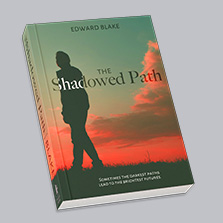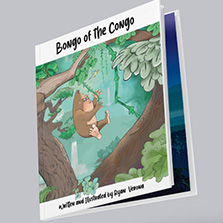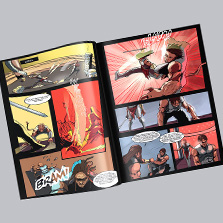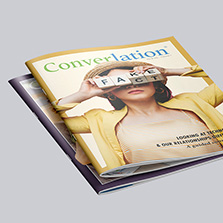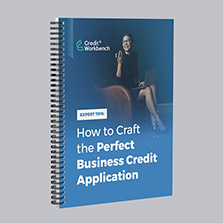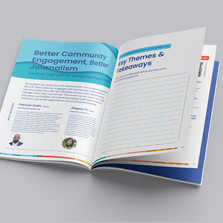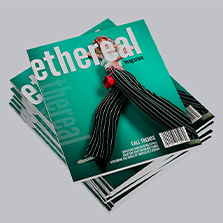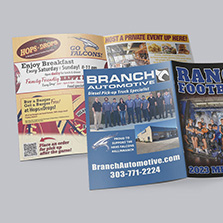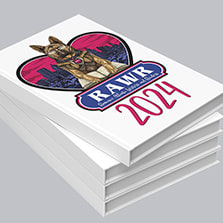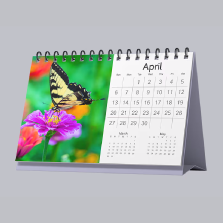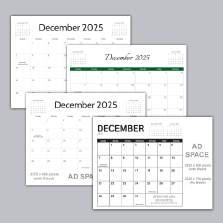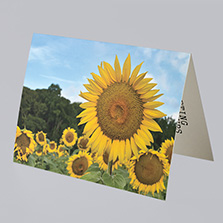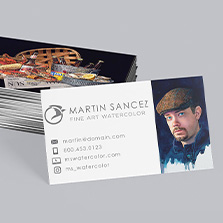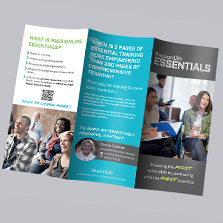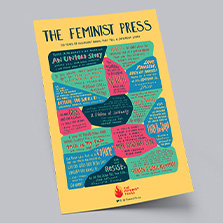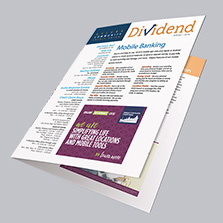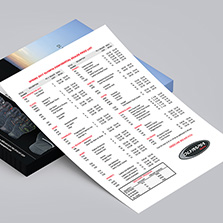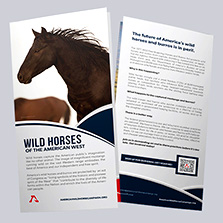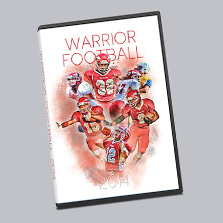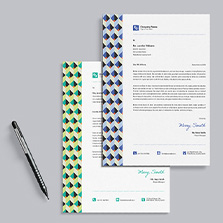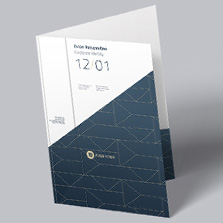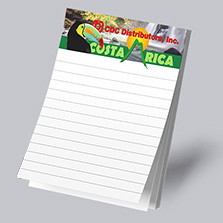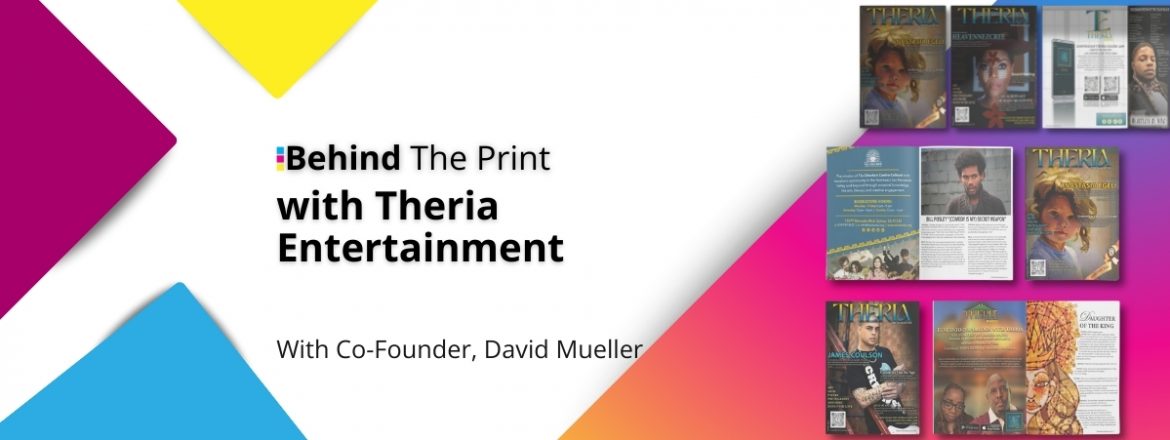
Behind the Print: Behind Theria
In this episode of Behind the Print, we’re joined by Theria Radio Co-Founder David Mueller, Songwriter Seb, and Poet Italo. Together, the three go into detail about how they use print to promote independent artists, musicians, and other creators get their craft in the spotlight.
Below, you’ll find the transcript of our conversation, edited for clarity to ensure easy reading. If you want the full, authentic experience, make sure to check out the video attached below.
Connor: Welcome back to the Behind the Print Podcast, where we feature industry leaders and uncover the creative minds and their businesses within the world of professional printing. Our mission is to provide you with inspiring actionable resources that elevate your business projects and accelerate your journey to excellence in profit and in print.
Today’s episode is Behind Theria. Joining me here today is David, Seb and Victor of Theria Entertainment. Welcome to the podcast gentlemen.
Seb: Thanks for having us.
Connor: Absolutely. Thanks for joining us. So if you guys are ready, let’s just dive right in. Sound good?
Seb: Let’s make it happen.
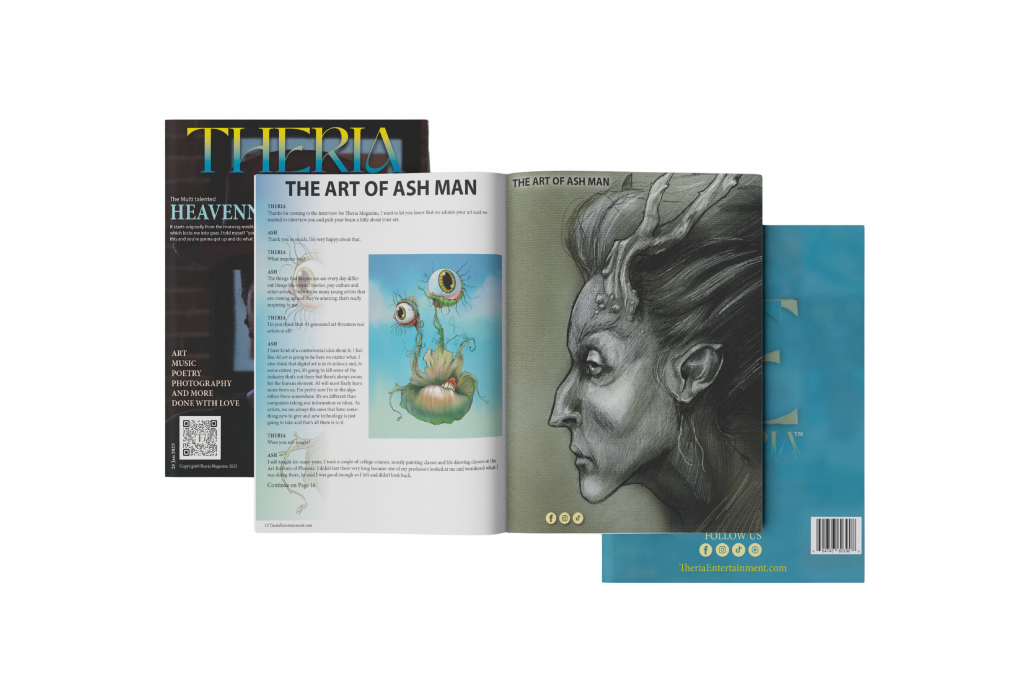
Connor: So tell me a little bit about yourselves and what you guys do.
Seb: Who wanna go first?
Italo: Go ahead, Seb.
Seb: I guess I’ll go first. Well, I’m actually an artist, singer, songwriter, so I’ve been going in L.A. I’ve been doing a lot of shows around L.A. actually after the pandemic, they made us sit down a second. So, um, that’s what we came up with. The whole Theria. I would tell you what Theria means too, because people always ask.
Connor: That was actually my next question is where did the name come from?
Seb: Well, when you ask it, I’ll let you let you do it. So when I created, Theria it was basically to spotlight indie artists, good ones.
And at first we started with the radio app. So we were moving on that, and then we came out with a magazine that showcases art and all its disciplines, you know, music, photography, poetry, those things. We’ve had some really great talented people out there. And, I’ll let it go to you, David.
David: Okay. So we’ve been working, well, it’s been two years now. We just had our two year anniversary on the 23rd.
“At first we started with the radio app. So we were moving on that, and then we came out with a magazine that showcases art and all its disciplines, you know, music, photography, poetry, those things. We’ve had some really great talented people out there.”
Connor: Congratulations.
David: Thank you. When we started the magazine portion, it was a lot of research to figure out what printer to use, what format we wanted to utilize, how many articles we wanted to have, and who we were going to invite to be on the cover.
So it was a little bit of a process, but we were able now to get our first anniversary issue out. So we’ve been doing the magazine for a year now.
Connor: Very good. Congratulations.
Italo: My name is Italo, but I also go by Victor for those that don’t know. I adopted the name Italo as my stage name, I’m a performer. I’m spoken word artist, a poetry artist, and storyteller. There’s many, many things in between. I met DJ and Seb. Back in 2016 I believe. I was already a writer, so I wrote this poetry about the Wizard of Oz characters, like Dorothy, the Scarecrow, the Witch and everything.
And then we got together. Seb is the one that told me “Hey. You got something there.” So we actually put a show together for the Hollywood Fringe Festival, which is a great festival or theater. So we put it together, that’s what we got together. And then. Um, that then we went to Russia of all places to put another show there.
When we got back we wanted to do something for independent artists because we’re independent artists. Something for independent artists, by independent artists. So we put out the Theria app radio, which is already running. It has a wonderful music. And I actually have a poetry podcast on there. It’s called Theory of Poetry Every Friday. And I like to discover new poetry, new artists. The magazine’s a more challenging thing because we had to now expand our horizons. And back in the pandemic times, we mostly operated on social media, but now that everything’s opened back up, we actually have to meet the artists in person. And that’s been a challenge, but it’s been a nice challenge because we found great artists out there. From painters, to storytellers, to poets to, sound healers.
We have so many things, on the magazine, and that’s what brought us to you guys, because we wanted to have a quality magazine. People having raving about the quality of the magazine. They’re like, “this is the best magazine ever”. They are so thrilled to get it. We wanted to tell you that. I don’t know if that tells you about me or about us, but that’s Theira Entertainment in a nutshell.

Connor: No, that sums it up nicely. I’m curious, where did the name come from?
Seb: When we came up with the name Theria, we were just out thinking. I’m just spitting these names out. “Ethereum?” no “Ethere?” I had to look it up first to see what it means. It means freedom and liberation.
Connor: Is that a Latin name?
Seb: It’s Greek actually. It’s part of my mom’s name actually. So I just took part of her name. Her name’s Yokatheria. The, so I took Theria and said you can keep that part and I’ll take this part. So that’s how it came out. And, it’s funny because people always ask questions, what is that? What does it mean? The name actually Freedom and Liberation, which fits well.
Connor: That does fit, that fits very
“It’s part of my mom’s name actually. So I just took part of her name. Her name’s Yokatheria. The, so I took Theria and said you can keep that part and I’ll take this part. So that’s how it came out. And, it’s funny because people always ask questions, what is that? What does it mean? The name actually Freedom and Liberation, which fits well.”
Seb: That’s how it came about. And the colors. If you look at it, the actual logo is, it’s a gradient. So it basically represents the sun rising, there’s the water, the setting and the trees on top. The trees represent people growing and expanding their art. It keeps getting bigger.
Connor: Yeah. I can see that. You guys help promote independent artists and you guys are based in L.A.
Seb: Yes.
Connor: So there’s obviously a ton of independent artists in L.A. That’s a very broad spectrum, but what can you tell me about your typical clients?
Seb: Actually there’s many. I do try to find people that are serious because some people who wanna do it for the novelty of it, so to speak. And then there’s those people that actually love what they do. They’re just creating and being themselves. Those are the ones that I like to target, the ones that actually love it. It’s from the soul basically. That’s stuff I actually like because it’s real, it’s real situations just come in music forms or will come in a poetry form. Some of them are storytellers so they will tell their stories that way. It’s funny because some of them are very shy about interviewing for the magazine.
It’s funny to me. But our job is just say “Ok calm down. You’re here. Just let it happen.” They’re very down to earth, which I like. Not to say we don’t have challenges with some people, but we do have a choice of who we going to pick and who we don’t pick. And then there’s a plethora of indie artists. So it’s really just digging through the bold to find the ones we want.
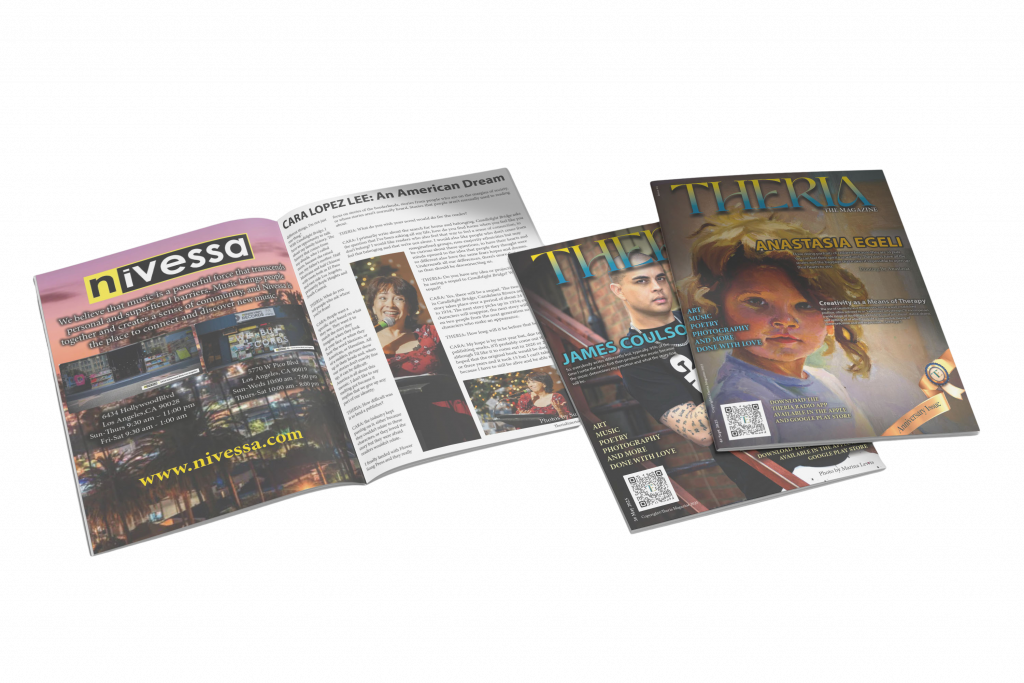
Connor: So you did touch on this, helping these artists come out of their shells, but what sort of problems do you typically help, these individuals solve?
Seb: Well, some of the artists, I try to get them to be themself. I would ask him like, well, “who are you?” That’s a hard question to answer, right? As much as you can, become aware of who you are now, and once you get that part, now tell me “who you are as an artist”, right?
Connor: Solid advice for both as an artist and just in general, just being true to yourself. Being yourself and not changing yourself to sort of fit in. How do you guys go about solving those problems?
“Well, some of the artists, I try to get them to be themself. I would ask him like, well, “who are you?” That’s a hard question to answer, right? As much as you can, become aware of who you are now, and once you get that part, now tell me “who you are as an artist”, right?”
Seb: Well, like I said before, I have to pick through a long list of clients, especially the ones that’s open. They have to be open to listening and they have to be teachable. Sometimes a lot of people aren’t teachable. Their pride gets in the way. So I usually go for the ones that are open enough to hear that, and really wanting to grow in their craft, not only in their craft, but in their self as well. We have to sift through our clients so we don’t have much of a problem with the people to put on the radio or the magazine. Or even in the events that we have,
Italo: I can I add to that, to that statement. So we have had difficulty with certain artists, right? We have to be very tactful because as artists are very emotional people, very fragile sometimes. So we try to be compassionate about it, by having forgiveness but not let them take us for granted. We’re trying to help them. If we elevate them, we get elevated too. It goes back and forth. So many of them want to be on Spotify and they want to be on billboards and they want to be on tv and they want to be, they want to have it now.
Connor: Yeah. Instant gratification.
Italo: And the problem is that takes long time and it takes a lot of people.
It takes a lot. We started Theria two years ago and the magazine came out a year later. Even that was a struggle because we have people we could interview, but what is the message? Do you have anything to say or you just want to be on the magazine? What is your purpose and what is your mission and what is your message? Is the message interesting?
And as you, as an interviewer, you can probably relate. To make them feel at ease and ask “What is your story? What do you have to say to the world? Are you willing to put in the work?”
Connor: I think there’s a lot of that going on in, in the world in general. People that want the reward without putting in the work.
Seb: Ooh, that’s a yes. Definitely. That’s definitely a big one.
David: One of the things that I think is really helping with a lot of the artists that we work is the exposure. They’re getting the exposure on the radio. If they’re a singer or a poet or a musician we have commercials for them.
We put them in the magazine and then help them in understanding how that is going to enhance what they’re doing and where they can go with their career, and with their gift.
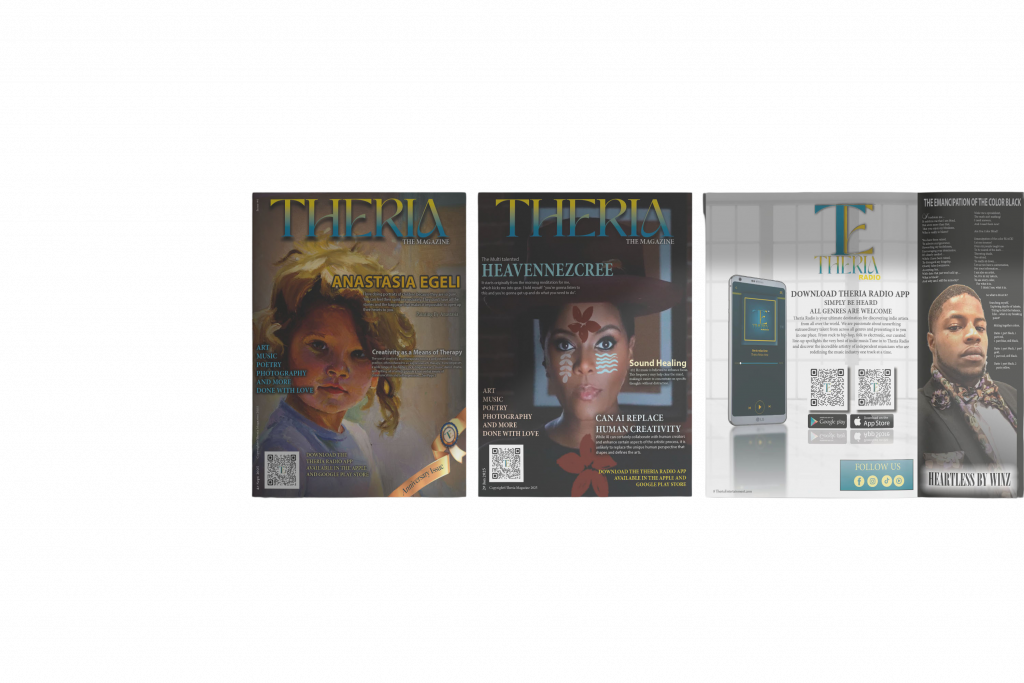
Connor: Well said. Well said. So in addition to music and poetry and photography, are there any other art forms that you guys focus on?
Seb: Well, Italo does stage plays. I’ll let you do that. It’s a lot.
Italo: Yeah, definitely. We started with the musicians and poets, but now we are trying to expand to different sorts of artists. We’re looking for glassblowers, we’re looking for people that do art with food, something outrageous.
We have people that have come through and we think “I don’t know if that’s an art. Is that an art? Let me see.” We also talk about mental health a lot in the magazine and how art is helping them heal. Mental health issues that they are solving through the arts. I like to see that. And if it piqued my interest, I’m sure it’s going to be interesting for people to read. I don’t know if that makes sense.
Connor: No, that absolutely makes sense.
“We have people that have come through and we think “I don’t know if that’s an art. Is that an art? Let me see.” We also talk about mental health a lot in the magazine and how art is helping them heal. Mental health issues that they are solving through the arts. I like to see that. And if it piqued my interest, I’m sure it’s going to be interesting for people to read.”
Italo: But we are trying to expand. I want our clients to give me something I haven’t seen before. Let me see what they have to say about what inspired them, how they started, because many of them are self-taught.
Seb: Mm-hmm. Absolutely. Well, that’s why I chose, Theria Entertainment because it’s broad. There’s many things can go under there and we can expand with entertainment names. We get a lot of musicians and painters, that’s what we get that the most. We haven’t gotten any tattoo artists, but we’re definitely looking.
Some people ask why we didn’t use a digital magazine. There’s a reason for that. I find that people like things tangible that they can hold. I like books. I don’t like reading on my phone like that. I like books and, something they can frame. You can’t do that with digital.
Connor: 100% agree.
Seb: Yeah, and, and mixing an old with the new, but keeping a traditional way as well, but use some of the new.
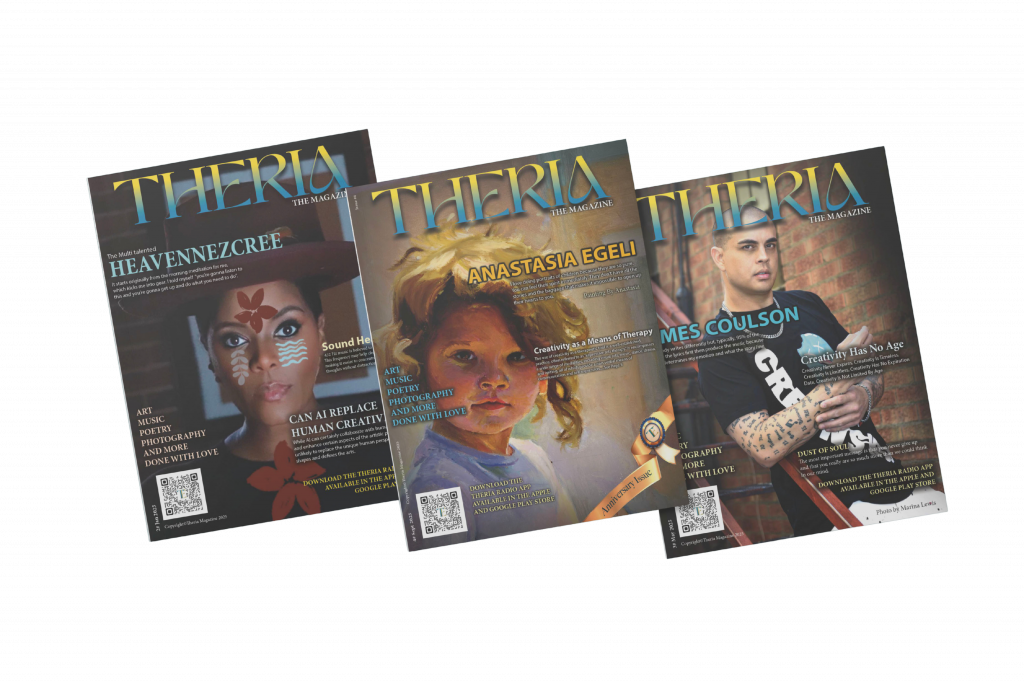
Connor: Definitely. I always felt that print feels more permanent. When you’re on your phone, whatever you’re looking at will go away as soon as you turn off your screen. But print is something that’s physical, like you said, something that’s tangible, something that you could put out on your coffee table or an end table. A guest opens it up and thumbs through it. And it might be something that they never would’ve done if they saw it on a screen.
Seb: Exactly. And it keeps them off the phone.
Connor: Mm-hmm. Exactly. Like you said, it gets them reading.
Seb: Exactly. I do find a lot of people don’t read.
Connor: Mm-hmm. I’ve seen that as well.
Italo: It’s exciting to see it on the magazine, something that attracts their attention and then suddenly they have to. I think that combining a balance between imagery and text. It’s very important for most people. They want to see something interesting.
Connor: Absolutely. So it sounds like you guys have, such a diverse range of clientele, but can you tell me about a client that has really stood out? That might be a difficult question considering what you guys do.
“It’s exciting to see it on the magazine, something that attracts their attention and then suddenly they have to. I think that combining a balance between imagery and text. It’s very important for most people. They want to see something interesting.”
Seb: Who stood out? That is kind of difficult. There’s this artist from South Africa. Her name is Carina Roger. It blew my mind. I thought “we need to put her on a cover”. We try to stay in the states with the cover people. But she was phenomenal, it’s wonderful work.
Italo: And she was self-taught. If you read the article, you realize these people are self-taught. She went to YouTube on how to do this and how to do that, and she did it herself and she’s been doing wonderful.
Connor: Not to discredit the power of print, but there is a how to video of literally everything on YouTube.
Seb: Yes. Everything, everything. Nobody has no excuse. Just funny because we never even asked each other this, this is a good question.
David: One of the people that stood out to me was Bill Ley. He’s a vet and an actor, screenwriter, and producer. He puts on comedy plays, but are based on things that really happens to his true experiences.
I’ve seen the second show a couple of times now. His stuff has been recognized and he is based here in L.A. but he has taken his show to New York and now to London. And he is very down to earth. He is such a nice person. You meet him and he’s, he is really open and easy to talk to.
He works a lot trying to help other vets with getting through their transitions from being a soldier to a civilian,
Connor: Definitely, that definitely stands out.
Italo: Besides this person on the cover, Heavennezcree, she started as, Glinda the Good Witch in my show that I put together. So when we interviewed her, I didn’t realize she was an actress, a photographer, a storyteller. She has so many things going on for her. She was so excited to be in the magazine. She was almost in tears. She’s a senior poet and she’s always on TikTok doing poetry. And she’s was so thankful and appreciative.
We build relationships with the people that we’ve interviewed. It doesn’t stop once a magazine prints, you know, and we forget about them. We keep in touch and they come back and , they want to come back for more. They want to, it cannot be another issue. It’s like, no, you can’t, but you, you know, you can buy another magazine.
Connor: Well, it sounds like a very personalized approach, and it sounds like all those artists you spoke to or just talked about all seem incredibly unique in their own right.
Seb: Mm-hmm. They are very,
Connor: So, next question, how do you guys stand out from other businesses in the field?
David: I think one of the ways that we stand out is that we celebrate independent artists. We don’t play with on the radio. We have such a diverse group of artists. Everything from pop to rock country, rap, you name it, we’ve got it. The same with poets.
We have people who are slam poets and people who are storytellers. They go from everything from painting to photography, to sculpting work. And we offer people an opportunity to show their arcs in a way that’s easy. It’s not something that’s real difficult for them to do.
Seb: I was also told also that Theria is bringing magazines back, but I think magazines have always been here. We’re just doing it our way. I don’t depend on social media a lot. I’m more of the real life type. I like the in-person stuff. I don’t like robots and A.I. I’m a human type person. So I try to bring that to the clients, the people we work with bring it. We’re human. You’re human, let’s make it happen.
Connor: And that’s another touch point the increasing popularity of A.I. It’s gotten to the point where it’s, pretty good, but you can still definitely tell it’s A.I. when it comes to art.
“I was also told also that Theria is bringing magazines back, but I think magazines have always been here. We’re just doing it our way. I don’t depend on social media a lot. I’m more of the real life type. I like the in-person stuff. I don’t like robots and A.I. I’m a human type person. So I try to bring that to the clients, the people we work with bring it. We’re human. You’re human, let’s make it happen.”
Seb: I think it’s missing a soul. It has no soul in it. It feels very stiff. I don’t allow people to submit AI songs. We can’t do that.
Or even with art, I don’t let them do that. Because I still, I want them to experiment with their own stuff, their own creativity. The whole goal is for them to bring their creativity. I don’t want A.I. to steal it away, you know what I mean?
I’m not saying I’m against A.I. but I don’t like it. I just feel like it’s taking from us, you know? What does that leave you as a artist creator? I want to keep it authentic. Because when you do art, any art in any form, it has to come from somewhere, right? Nobody lives your experience. Only you can convey that.
Connor: I think a good example of that would be Johnny Cash’s later works. His voice definitely changed towards the end of his life. It’s definitely a lot different than when he was singing Folsom Prison Blues. It’s weathered in a way that I find it very charming. It’s the progression of his, his life in those imperfections.
So next question, and I’m pretty sure I already know the answer to this, but how has Print helped elevate your business?
Seb: You want go for it DJ?
David: Okay. I think by being in print, it’s giving people, the opportunity to see what we’re doing and not just think of it as a concept.
We’ve shown the magazine to prospective partners for advertising and it shows them what we’re about, what we’re working on, where we’re taking this, and the quality of what we want our work to be. It solidifies it.
Seb: And I think people like things tangible. We actually framed each one we get. But I think it’s the tangible aspect. People like things they can hold, especially when they’re featured in it.

Connor: Adding to that, print is mostly visual, but there also is a tactile sensation you get from it when you’re holding it in your hands. You feel the texture of the paper.
Seb: And the heaviness of it
Connor: Exactly.
Seb: And the colors too. The print quality is amazing.
Connor: We appreciate that. We appreciate you guys printing with us and we’re very happy that you’re pleased with our product.
Seb: Love it. Absolutely love it.
Italo: I have a question for you guys, for you, Connor; How many magazines do you guys print on average? Like, do you have a lot of. People doing that?
Connor: That is a fantastic question. We print probably thousands of magazines a year. I guess it depends on what you would consider a magazine. We print products like your magazine, but we also use the same printing style for things like dance recital programs, or for things like a softball roster or for church pamphlets. It’s definitely still a viable option for getting your message out there.
Seb: Exactly, because people like tangible.
Connor: Can you guys tell me about any major milestones that have defined your company?
Italo: I would actually say the inauguration that we had last year. That was our first magazine event. We had a place here in Hollywood called the Bourbon Room. We had the people that were in the magazine in attendance. It was amazing to meet them in person too. Because usually we only see them on social media and, it was interesting to see them in person. So that was a milestone. It made them feel special.
Seb: They also got to perform. We had their name on the back. It was lovely. The whole thing was lovely and they enjoyed it.
“I would actually say the inauguration that we had last year. That was our first magazine event. We had a place here in Hollywood called the Bourbon Room. We had the people that were in the magazine in attendance. It was amazing to meet them in person too. Because usually we only see them on social media and, it was interesting to see them in person. So that was a milestone. It made them feel special.”
Connor: That sounds lovely.
Seb: Yeah. And we had the teal carpet. We don’t have a red carpet. It’s the teal carpet. Why teal? It basically represents the theory of colors. So everything we do is going be the theory of colors, you know, that’s like part of the whole branding and all of that. So everything we do is going to be teal. It’s calming energy.
Connor: Can you guys tell me about any challenges or obstacles that are holding you back right now?
Seb: Holding us back. I wouldn’t say it’s holding back. It’s just a challenge. That’s a good way to look at it. Social media is one. Because most people want to be on their own on their own agendas. Like I said, they think they can do it themselves.
That’s how I differentiate from the people who’s serious and love what they do and willing to take those steps. A big part of it is teaching them patience. That’s a challenge because everybody wants that instant gratification and I’m trying to give them the delayed gratification to show them that they’ll appreciate this later.
I always use the garden analogy for them. Go plant a garden. You’re not going to get them tomatoes tomorrow. Right? You got to wait. And when that tomato come up, it’s green. You still can’t pick it, you wait, but once you get it, you going to enjoy it because you put the work into it, you know, you, you earned it, you know?
Connor: I’d say that delayed gratification is definitely something that you can savor more something. You work for it, and when you finally achieve it, it is so much more satisfying.
Seb: Mm-hmm. And it has a root, you know, like you plant a seed, you know it grows down first to attach yourself. Right. Then all the other stuff comes out. That’s why you enjoy it more and it has longevity. So when there are moments like when things feel slow, which is fine, but it’s moving faster than we think it is.
To me it just tells me “this is going to be lovely”. Because we’re not rushing. It’s a foundation being laid. Whereas now people want things fast. There’s no foundation. So it leaves quick, what we call it microwave style. Because microwave food is never good, but it’s fast. Not like if you were cooking a meal and taking the time to season it and all those things, you know? It’s just like, “Okay, here we go. This is a lovely situation”. Sometimes bad ones happen, but I feel like it’s all in how you look at it.
“It has a root, you know, like you plant a seed, you know it grows down first to attach yourself. Right. Then all the other stuff comes out. That’s why you enjoy it more and it has longevity. So when there are moments like when things feel slow, which is fine, but it’s moving faster than we think it is.”
David: Every detour is a lesson.
Seb: Mm-hmm. I don’t Did that answer the question?
Connor: Yeah, that was answered it perfectly. So next question, kind of a different question: If you guys had a day completely free to spend, how you’d like, how would you spend it?
Seb: , Traveling. I want to go to Yosemite.
Italo: I want a tour around, you know, the US and the world
David: I would probably spend it at the ocean with my grandkids.
Connor: Yeah. I guess you guys are right on the coastline, aren’t you?
Seb: Mm-hmm.
David: Yep.
Connor: So one last question. How can our listeners get in touch with you, learn more or collaborate with you guys on a project?
Seb: They can always go to the website TheriaEntertainment.com, or you can go to TheriaRadio.com and all of that.
It all coincides with each other, so you can get a hold of us there. Or you can download the app if you want. When you download the radio app, it’s all there.
Connor: Well, very good. Did you guys have any questions for me?
Seb: I don’t have any. I enjoyed this. Thank you again for having us.
Connor: We appreciate you printing with us, and we appreciate you taking the time to join us on the podcast.
Seb: Definitely.
Italo: It’s been a pleasure.
Connor: All right. Well, I’d say that’s a wrap on another episode of Behind the Print. Thank you to our listeners for joining us as we explore the artistry and innovation of the printing world. Remember, having a strong vision, building the right strategy, and using tools like Print to amplify your message, will make your brand stand out from the crowd.
If you enjoyed today’s episode, be sure to get yourself a sample pack today from printing center usa.com and share it with your fellow business enthusiasts. Until next time, keep those creative sparks flying. And remember, there’s always more to discover behind the print.


